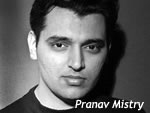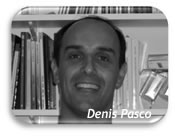|
PHYSICAL EDUCATION AND THE SIXTH SENSE:
2025, A SCENARIO FOR THE FUTURE
by Denis
Pasco, European University of Brittany
at Brest
  (a
fiction story based on current, new
technology) (a
fiction story based on current, new
technology)
Today, in 2025, we no longer live with
technology. We live through
technology. This process started in
2009 with Pranav
Mistry's invention called the Sixth
Sense.
The Sixth
Sense is a wearable
device that offers the opportunity
to bring digital objects or information
into the real world. Almost two decades
ago, in November 2009, Pranam Mistry
described this technology as a bridge
between the digital world and the physical
world. Over millions of years, we have
used our five senses to interact with
the world around us, explains Pranav
Mistry. But, in this interaction,
the most useful information that can
help us make the right decision is not
naturally perceived. This information
and knowledge accumulated about everything
is available online:
Although the miniaturization of computing
devices allows us to carry computers
in our pockets, keeping us continually
connected to the digital world, there
is no link between our digital devices
and our interactions with the physical
world. Information is confined traditionally
on paper or digitally on a screen.
Sixth Sense bridges this
gap, bringing intangible, digital
information out into the tangible
world, and allowing us to interact
with this information via natural
hand gestures. Sixth
Sense frees information from
its confines by seamlessly integrating
it with reality, and thus making the
entire world your computer.
This invention
became a revolution when we realized
that Sixth
Sense Technology will affect the
way we sense the real world around us.
Between 2011 and 2018, Microsoft, Sony,
and Nintendo research labs worked on
the large diffusion of this technology
in industrial societies. In 2025, people
live with a sixth sense providing a
bridge between the physical world and
the digital world. We design what we
call mixworlds by adding objects
and/or information of the digital world
into the real world. Each mixworld
is personal and depend on the objects
and/or information we add in a specific
real world situation. Parents design
mixworlds for their children
depending on the abilities/capacities
they expect them to develop. They also
share these mixworlds with
other parents in the community. In 2025,
children are raised through these mixworlds.
In education,
the first issues surrounding this new
technology arose when students brought
their Sixth
Sense in to the classroom. They
added digital objects into the real
world to play during the class. They
answered teachers' knowledge and procedural
questions by browsing their digital
world. Schools were not prepared to
face this new reality. Some adopted
conservative responses, prohibiting
the Sixth Sense. Newspaper
articles tracking school and community
responses to the Sixth Sense
caught the public's attention and quickly
become a societal issue. School boards
discussed prohibiting its use; critics
claimed it was cheating, while advocates
argued that the educational focus no
longer should be on memorization in
schools, but on using digitally available
knowledge for decision-making and problem
solving in schools.
The governmental
response was global because Sixth
Sense promoted mutual understanding
among people by solving language problems.
Translation was no longer necessary
because as you speak in your mother
language, Sixth Sense translates into
the language you choose in real time.
People who were deaf and hard of hearing
quickly embraced Sixth Sense,
speaking by tapping on their virtual
keyboard. The government's global response
initiated in 2015 was called, "Life
with Sixth Sense Technology."
This initiative consisted of two parts:
to increase the diffusion of Sixth Sense
Technology around the world and to examine
how Sixth Sense Technology affected
human beings. Government supported research
was conducted in many fields to study
the impact of this new technology on
human beings (or life?).
In education,
a worldwide coalition of educational
leaders develop a plan called "Sixth
Sense Technology: New Ways For Teaching
and Learning In Schools."
The aim of the program, initiated in
2018, was to increase student learning
using Sixth Sense Technology. The plan
redefines student and teacher roles
in the learning process, providing guidelines
for teachers to design Sixth Sense Technology
learning environments and supporting
teacher training sessions provided by
University teacher education programs.
Sixth Sense Technology facilitated the
transition to constructivist, student-centered,
teaching, and learning environments
in every subject area. New curricula
in mathematics, science, history, and
languages, for example, promoted problem
solving and assisted students to apply
school knowledge in meaningful and useful
community environments.
Because Sixth
Sense Technology affected the way we
sense the real world around us, physical
education became a central part of the
Sixth Sense Technology, serving as an
example of active, student-centered
ways of teaching and learning in schools
plan. A world-wide coalition of Physical
Education leaders designed the first
global physical education curriculum
implemented in 2020. Today in 2025,
this curriculum is composed by all student
experiences in physical education mixworlds.
These mixworlds are learning
environments which include objects and
information of both the digital and
the real worlds. The content is based
on problem solving.
These problems
are movement-based. Teachers design
mixworlds depending on what
they want students to learn. They share
their mixworlds with other
physical education teachers. In 2025,
we teach physical education through
these mixworlds. You can create
your own or upload mixworlds
designed by others. There are mixworlds
to learn fitness concepts, games tactics,
sports skills, personal and social reasonability,
and so on. Students use a set of knowledge
available in both the digital and the
real world to solve problems. NASPE
organizes competitions to challenge
physical education teachers on mixworlds.
They present and demonstrate their best
mixworld.
All students'
physical education experiences are available
in their own personal digital world.
Teachers access these to understand
their students' prior experiences and
knowledge, and planning curriculum and
learning experiences individualized
for each student. This access has strongly
increased student learning in physical
education because teachers design mixworlds
based on each students' prior experiences.
With the Sixth
Sense Technology, physical
education teachers' efficiency is based
on their ability to put in practice
the three "right" rules: provide
the right content to the right
student at the right time.
Students are assessed on their abilities
to find and use appropriate knowledge
to solve complex problems.
The
author would like to thank Pr. C. Ennis
(UNCG) who generously made suggestions,
comments, and edited English.
Denis
Pasco Ph.D., is professor at the European
University of Brittany at Brest (France).
He holds a Bachelor’s degree from
the University of Caen, a master and
Ph.D degrees from European University
of Brittany at Rennes. He was rank 2
on the National Physical Education Teaching
Agregation Diploma. Previously, he held
a position at the Department of Physical
Education of the École Normale
Supérieure de Cachan. His research
focuses on the design and the evaluation
of Virtual Reality Learning Environments
(VRLE).
He
has studied the transfer of learning
in AréViRoad, a traffic road
VRLE to teach drivers how to behave
on the road. He has worked on the pedagogical
design and evaluation of VirteaSy©,
a virtual reality learning environment
in implantology and has also collaborated
in the design of Platsim, a network
driving simulator platform for crisis
management.
Professor
Pasco has published over 20 research
articles in peer-review and professional
journals, given 30 presentations in
international and national audiences,
and has a published chapter in the Handbook
of Sport Psychology. He has been an
investigator for the European Virtual
Reality Lab of the research projects
Platsim (1.6 M€), Formarev (53k€)
and Didhaptic (15k€). He is a member
of the American Educational Research
Association (AERA), the Alliance for
Health, Physical Education, Recreation,
and Dance (AAHPERD), and the French
Virtual Reality Research Association
(AfRV). |



